
Onsite Research
Research Capabilities and Facilities
 As the lead field center for the DOE Office of Fossil Energy's research and development program, NETL has established a strong onsite research program conducted by Federal scientists and engineers. Onsite R&D – managed by NETL's Office of Research and Development – makes important contributions to NETL's mission of implementing a research, development, and demonstration program to resolve the environmental, supply, and reliability constraints of producing and using fossil resources. As the lead field center for the DOE Office of Fossil Energy's research and development program, NETL has established a strong onsite research program conducted by Federal scientists and engineers. Onsite R&D – managed by NETL's Office of Research and Development – makes important contributions to NETL's mission of implementing a research, development, and demonstration program to resolve the environmental, supply, and reliability constraints of producing and using fossil resources.
With its expert research staff and state-of-the-art facilities, NETL has extensive experience in working with the technical issues related to fossil resources. Onsite researchers also participate with NETL's industrial partners to solve problems that become barriers to commercialization of power systems, fuels, and environmental and waste management. Onsite research capabilities are strengthened by collaborations with well-known research universities.
The following are core R&D capabilities and facilities of NETL's locations in Morgantown, West Virginia; Pittsburgh, Pennsylvania; Tulsa, Oklahoma; Albany, Oregon; and Fairbanks, Alaska.
Carbon management
NETL is making impressive advances in research on carbon sequestration – one of today's most promising options to manage emissions of carbon dioxide (CO2 ) from energy production and use. NETL conducts R&D on separation and capture of CO2 from power plants and industrial processes. Researchers are investigating sorbent/catalyst development, gas/solid interactions, and surface characterization to enhance the ability of filters to separate and capture such impurities as CO2 , SO2 , NOx , and hydrogen from fuel gas streams. Desulfurization sorbents have been developed for a wide range of temperatures and for use with different fuel gas streams. This work has been patented, licensed, and published.
NETL research and ongoing data collection on CO2 storage in geologic formations (unmineable coal seams, and oil, gas, and saline reservoirs) have led to significant advances. Models that predict CO2 storage capacity and the permanence of CO2 storage are being field-tested to demonstrate how carbon sequestration can dramatically mitigate potential impacts of greenhouse gas emissions. These models also monitor and verify the behavior of CO2 when injected into oil fields – one successful way of increasing oil production (enhanced oil recovery). NETL research also is contributing to the development of cost-effective and environmentally sound CO2 measurement, monitoring, verification, and storage technologies.
Relevant resources:
Chemical reaction engineering
NETL scientists and engineers, in collaboration with the Computational Science team, are developing fundamental models for calculating reaction rates and equilibrium associated with the combustion and gasification of fossil fuels, chemistry of production of ultra-clean fuels, hydrogen separation and storage technology, and surface science and catalysis. This research also includes developing three-phase reactor models for fuels production, and enhancing NETL's mechanistic multi-phase modeling code (MFIX) with Cartesian meshing, large eddy simulation, discrete element solver, n-phase implementation, and chemistry and heat transfer improvements. Researchers link computational and experimental research to take advantage of both strengths, such as in several studies on fuel and polymer interactions – demonstrating the ability of molecular modeling to predict swelling behavior of polymer seals based on fuel composition.
Relevant resources:
Combustion science
NETL combustion science research provides the basis for a new generation of advanced fossil fuel conversion technologies necessary to meet future demands for efficient, clean, and cost-effective energy production. Combustion science researchers conduct exploratory and applied research in the areas of combustion science technology, and dynamics of engines and other energy conversion devices. This includes modeling, simulation, and laboratory-scale studies of advanced combustion turbines, as well as larger investigations involving turbine combustion of coal syngas and high hydrogen content fuels. Research also addresses combustion stability, detection and control of flashbacks, fuel variability, oxy-fuel combustion applications for gas turbines, and novel combustor designs yielding low NOx emissions with high hydrogen fuels. Development of advanced turbines with low-NOx emissions (less than two parts per million) operating on coal syngas or high hydrogen fuels supports DOE's goal of coal plants capable of producing hydrogen and electricity with near-zero emissions by 2020. Additional research on the integrated removal of pollutants from fossil-fueled power plants investigates an approach that fully integrates emission handling from conventional fossil-fueled plant design by compressing flue gases with substantial heat recovery to improve efficiency.
Relevant resources:
Computational research
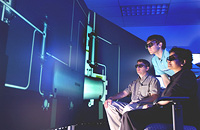 NETL develops computational energy systems that are helping to overcome major technical challenges to developing new fossil fuel technologies and systems. Researchers are developing a world-class modeling and high-performance computing infrastructure to aid of the development of next-generation, clean fossil energy technologies. To bolster its capabilities in computational research, NETL uses supercomputer clusters optimized for computational fluid dynamics and computational chemistry calculations and high-speed network connections for transferring gigabytes of simulation data in a matter of minutes. For example, researchers use high-performance computers to screen alloys with properties tailored to specific purposes, such as future hydrogen production. Working with a regional supercomputing consortium of academia and government, NETL is utilizing the “Lemieux” supercomputer to reduce the time for detailed calculations and thereby make the results available on time for the development of advanced technologies. Transient 3-D computer simulations – used to validate advanced coal-fueled power systems at the Power Systems Development Facility in Alabama and to design a Clean Coal Power Initiative transport gasifier – are now being completed in days rather than months with the assistance of supercomputers. NETL develops computational energy systems that are helping to overcome major technical challenges to developing new fossil fuel technologies and systems. Researchers are developing a world-class modeling and high-performance computing infrastructure to aid of the development of next-generation, clean fossil energy technologies. To bolster its capabilities in computational research, NETL uses supercomputer clusters optimized for computational fluid dynamics and computational chemistry calculations and high-speed network connections for transferring gigabytes of simulation data in a matter of minutes. For example, researchers use high-performance computers to screen alloys with properties tailored to specific purposes, such as future hydrogen production. Working with a regional supercomputing consortium of academia and government, NETL is utilizing the “Lemieux” supercomputer to reduce the time for detailed calculations and thereby make the results available on time for the development of advanced technologies. Transient 3-D computer simulations – used to validate advanced coal-fueled power systems at the Power Systems Development Facility in Alabama and to design a Clean Coal Power Initiative transport gasifier – are now being completed in days rather than months with the assistance of supercomputers.
NETL develops computer models of power plants that range from the plant scale to device scale by judiciously combining commercial software with software developed at NETL. The Advanced Process Engineering Co-Simulator (APECS) software was developed to model a power plant in its entirety, while including detailed models of critical equipment items. APECS will allow engineers to simulate and visualize advanced power plant concepts, such as FutureGen. To model device-scale phenomena, NETL researchers developed the M ultiphase F low with I nterphase E x change (MFIX) software and its underlying physics and numerical techniques. This software was developed to address the unique need for modeling multiphase reactors inevitably found in fossil fuel plant designs. MFIX is used, for example, to simulate hydrodynamics in scaled-up designs of state-of-the-art gasification technology. NETL has made this software available as open-source, and it is being used by researchers worldwide to model a variety of multiphase phenomena ranging from coal gasification to pyroclastic flows resulting from volcanic eruptions.
To fully exploit the results of detailed computational models, NETL has developed capabilities for visualizing the results of high-fidelity simulations ranging from computational chemistry to fluid dynamics for advanced power generation systems. NETL's virtual reality environment renders the massive amount of data generated by the detailed models in a readily understandable visual form. The immersive environment allows engineers to make changes to a new plant concept and immediately “see” the impact on the entire plant.
Relevant resources:
Environmental science
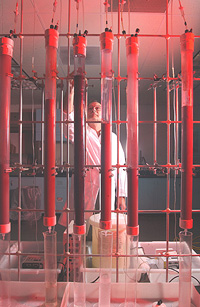 NETL researchers are developing innovative technologies to help solve environmental issues related to energy extraction, processing and utilization, and combustion by-product use through exploratory and applied research. Researchers support all NETL programs in the areas of environmental technologies, geosciences, and emission reduction. Their research is conducted primarily to develop novel processes, efficiency improvements, cost reduction, environmental quality enhancement, product quality improvement, waste reduction, and material recycling in the areas of environmental and energy technologies. For example, in the area of clean water, NETL is conducting basic and applied research related to the prediction, prevention, and treatment of water contaminated by the mining and processing of coal and metals. This research includes developing inexpensive water treatment technologies for inactive and abandoned sites that are the problems of local, State, and Federal agencies. NETL is developing technical solutions for the management of wastes generated during the mining, processing, and utilization of coal. These materials include: fly ash and other by-products of coal combustion, tailings, mine spoil, coal-cleaning residues, and contaminated soil. Onsite researchers also are involved with developing and demonstrating new environmental technologies to supplant current engineering practices. NETL identifies environmental needs by reaching out to businesses, governments, and academia; uses laboratory, modeling, and other resources within NETL and its partners to explore selected concepts; and conducts proof-of-concept experiments and field demonstrations. NETL researchers are developing innovative technologies to help solve environmental issues related to energy extraction, processing and utilization, and combustion by-product use through exploratory and applied research. Researchers support all NETL programs in the areas of environmental technologies, geosciences, and emission reduction. Their research is conducted primarily to develop novel processes, efficiency improvements, cost reduction, environmental quality enhancement, product quality improvement, waste reduction, and material recycling in the areas of environmental and energy technologies. For example, in the area of clean water, NETL is conducting basic and applied research related to the prediction, prevention, and treatment of water contaminated by the mining and processing of coal and metals. This research includes developing inexpensive water treatment technologies for inactive and abandoned sites that are the problems of local, State, and Federal agencies. NETL is developing technical solutions for the management of wastes generated during the mining, processing, and utilization of coal. These materials include: fly ash and other by-products of coal combustion, tailings, mine spoil, coal-cleaning residues, and contaminated soil. Onsite researchers also are involved with developing and demonstrating new environmental technologies to supplant current engineering practices. NETL identifies environmental needs by reaching out to businesses, governments, and academia; uses laboratory, modeling, and other resources within NETL and its partners to explore selected concepts; and conducts proof-of-concept experiments and field demonstrations.
Researchers utilize a large number of NETL onsite laboratories and facilities. Key facilities include: thermogravametric and microbalance reactors; packed-bed reactors, which are being used to evaluate removal function of regenerable sorbents/catalysts for NOx, carbon dioxide, mercury and other trace elements; microbiological laboratories and bench-scale bioreactors; a pilot-scale water treatment facility, being utilized to evaluate the use of biologically-generated sulfate reduction technology; established laboratory-scale leaching operations, with associated analytical support; various electromagnetic and geophysical technical capabilities; and an onsite underground research coal mine.
Relevant resources:
Fuel cell research
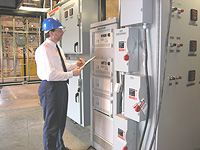 NETL researchers are playing a key role in advancing fuel cell technology, conducting research that will help change the form and function of this important power technology. For example, onsite researchers are investigating how contaminants contained in gasified coal degrade fuel cell performance; their goal is to discover the optimal s ulfur-tolerant anode material to avoid those negative impacts. In addition, the researchers are developing low-cost conductive coating materials and coating methods for fuel cell interconnects. Other research occurring in partnership with regional universities includes identifying the mechanism of material phase interactions and transformations at the cathode-electrolyte interface. Finally, NETL's f uel processing R&D is leading to better, more compact ways to transform diesel fuels to hydrogen needed by the fuel cell. Work on fuel reforming systems that operate fossil fuel-derived fuels – diesel and synthesis gas as well as hydrogen – are pushing the envelope for fuel cell applications. NETL researchers are playing a key role in advancing fuel cell technology, conducting research that will help change the form and function of this important power technology. For example, onsite researchers are investigating how contaminants contained in gasified coal degrade fuel cell performance; their goal is to discover the optimal s ulfur-tolerant anode material to avoid those negative impacts. In addition, the researchers are developing low-cost conductive coating materials and coating methods for fuel cell interconnects. Other research occurring in partnership with regional universities includes identifying the mechanism of material phase interactions and transformations at the cathode-electrolyte interface. Finally, NETL's f uel processing R&D is leading to better, more compact ways to transform diesel fuels to hydrogen needed by the fuel cell. Work on fuel reforming systems that operate fossil fuel-derived fuels – diesel and synthesis gas as well as hydrogen – are pushing the envelope for fuel cell applications.
Geosciences
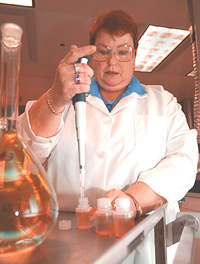 NETL researchers are evaluating and developing new technologies related to geophysical and geological reservoirs. These technologies include airborne and ground-based electromagnetic conductivity, frequency domain, magnetometry, ground-penetrating radar, novel tracers, methods for direct monitoring of carbon dioxide fugitive emissions and proprietary software developed at NETL. For example, using a helicopter-mounted "frequency-domain electromagnetic" device, NETL researchers have developed 3-D images of groundwater flow in Pennsylvania, the Wyoming-Montana border, and California. Researchers also have used ground-based magnetometry and perfluorocarbon tracers (PFTs) at oil recovery sites to find abandoned wells and fugitive carbon dioxide emissions that could be critical to long-term carbon sequestration efforts. Direct carbon dioxide monitoring techniques and PFTs have been used during sequestering field activities to identify minute fugitive emissions. In addition, NETL's basic and applied research is centered on solving regional and national water pollution problems. Onsite researchers have developed models for simulating flow in fractured media, and pioneered the treatment of coal mine drainage by developing techniques now commercialized to cost-effectively treat polluted mine drainages. NETL has also worked on remote monitoring of water-powered systems, and bioremediation of soils contaminated by oil and natural gas wells. NETL is assessing the feasibility of using pooled mine water and/or mine water discharges as thermal reservoirs for heat pump applications. The economics appear to be quite favorable. NETL researchers are evaluating and developing new technologies related to geophysical and geological reservoirs. These technologies include airborne and ground-based electromagnetic conductivity, frequency domain, magnetometry, ground-penetrating radar, novel tracers, methods for direct monitoring of carbon dioxide fugitive emissions and proprietary software developed at NETL. For example, using a helicopter-mounted "frequency-domain electromagnetic" device, NETL researchers have developed 3-D images of groundwater flow in Pennsylvania, the Wyoming-Montana border, and California. Researchers also have used ground-based magnetometry and perfluorocarbon tracers (PFTs) at oil recovery sites to find abandoned wells and fugitive carbon dioxide emissions that could be critical to long-term carbon sequestration efforts. Direct carbon dioxide monitoring techniques and PFTs have been used during sequestering field activities to identify minute fugitive emissions. In addition, NETL's basic and applied research is centered on solving regional and national water pollution problems. Onsite researchers have developed models for simulating flow in fractured media, and pioneered the treatment of coal mine drainage by developing techniques now commercialized to cost-effectively treat polluted mine drainages. NETL has also worked on remote monitoring of water-powered systems, and bioremediation of soils contaminated by oil and natural gas wells. NETL is assessing the feasibility of using pooled mine water and/or mine water discharges as thermal reservoirs for heat pump applications. The economics appear to be quite favorable.
Relevant resources:
High temperature/high pressure science
High operating temperatures and pressures inherent in advanced power systems necessitate the development of a new variety of materials, alloys, sorbents, and filtration devices. NETL has researchers and facilities capable of addressing these needs in areas such as materials development and testing, chemical looping processes, and hydrogen and CO2 separation methods. For example, chemical looping in coal-based, hybrid combustion-gasification systems has the potential to achieve near-zero CO2 emissions, exceed all current environmental regulations, and meet or exceed integrated gasification combined-cycle efficiencies. High-pressure CO2 separation is seen as a way to reduce carbon capture costs, while high-temperature and high-pressure hydrogen separation and membrane research is a key component in the future hydrogen economy. NETL researchers also utilize membrane reactors with the capability of high-pressure, high-temperature hydrogen permeation testing. Researchers using the Advanced High Temperature, High-Pressure Transport Reactor have demonstrated acceptable hydrodynamic and gasification performance of the Transport Reactor Development Unit (TRDU) under varying conditions while using bituminous and subbituminous coals and other fossil fuels. The focus of this research has been on understanding and improving the operation of the transport gasifier itself to support larger-scale operation at the Power Systems Development Facility (PSDF) in Wilsonville, Alabama.
Relevant resources:
Methane hydrates research
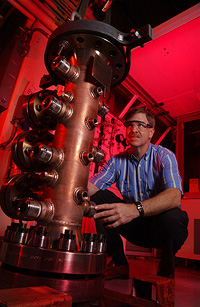 To ensure long-term domestic natural gas supplies, NETL is pursuing ways to produce methane from methane hydrate deposits. NETL onsite researchers collaborate with several universities and national laboratories, each working on particular research areas to avoid duplication, to meet the DOE target for commercial methane hydrate production by 2015. NETL's focus is on: (1) permeability of sedimented hydrates, (2) capillary flow within sediments, (3) thermo-physical properties, and (4) computational modeling of fluid flow within hydrate reservoirs. Experiments are conducted on methane hydrate samples – some synthesized at NETL and others recovered during DOE-sponsored coring of hydrate deposits – to better understand their structure and thermal properties and develop means to cost-effectively extract the usable gas. In support of these experiments, seven methane hydrate cells have been constructed by NETL researchers with sizes varying from 40 milliliters to 15 liters – one of the largest hydrate view cells in the United States. To ensure long-term domestic natural gas supplies, NETL is pursuing ways to produce methane from methane hydrate deposits. NETL onsite researchers collaborate with several universities and national laboratories, each working on particular research areas to avoid duplication, to meet the DOE target for commercial methane hydrate production by 2015. NETL's focus is on: (1) permeability of sedimented hydrates, (2) capillary flow within sediments, (3) thermo-physical properties, and (4) computational modeling of fluid flow within hydrate reservoirs. Experiments are conducted on methane hydrate samples – some synthesized at NETL and others recovered during DOE-sponsored coring of hydrate deposits – to better understand their structure and thermal properties and develop means to cost-effectively extract the usable gas. In support of these experiments, seven methane hydrate cells have been constructed by NETL researchers with sizes varying from 40 milliliters to 15 liters – one of the largest hydrate view cells in the United States.
NETL recently launched an investigation of the physical properties of natural gas hydrates with the goal of developing an improved understanding of the physical properties of methane hydrate for potential gas production from vast U.S. reserves. This activity is being conducted in conjunction with the University of Oklahoma (kinetic modeling focus), University of Pittsburgh (modeling tasks), and Oak Ridge National Laboratory (natural sediment physical properties focus). A major focus of this effort is to develop the models that will predict the recoverable resources from gas hydrate deposits, profitable lifetime of the reservoir, and total recoverable resource available. However, physical properties (e.g., thermal conductivity, flow permeability, and capillary pressures) of methane hydrates in sediments are not well understood. As NETL researchers gain a better understanding of these properties, better reservoir simulator models will be developed, which will support the development of this vast domestic energy resource.
Relevant resources:
Reciprocating engines research
Reciprocating engines (internal combustion engines) are widely used in the transportation sector (e.g., automobiles, trucks, trains) and increasingly as distributed generation technology. NETL is conducting research in the areas of advanced materials, unique fuel handling and processing systems, and advanced ignition and combustion systems for reciprocating engines. NETL researchers are conducting research in laser spark ignition, which is part of the national effort to design, develop, test and demonstrate a new generation of reciprocating engine systems. These systems for distributed energy applications will be cleaner, more affordable, more reliable, and more efficient than products that are commercially-available today. A key facility in support of NETL's research in this area is its reciprocating engine laboratory where researchers demonstrated the ability to operate a laser-fired diesel engine on extremely lean fuel, much leaner than possible with traditional spark ignition.
Relevant resources:
Remote sensing
NETL is helping to pioneer the development of remote or airborne sensing technologies, which provide new tools for watershed assessment. For example, NETL researchers use helicopters and low-frequency electromagnetic and infrared imagery to gather information on otherwise inaccessible areas and develop large-scale mapping of pipeline leak detection, drainage, and underground aquifers. The advantage of this aerial approach is that large land areas can be surveyed in a matter of days, as opposed to current methods that include surveying large areas by foot, which may take years. Additionally, airborne surveys minimize land access problems, which hinder land-based surveys. NETL is evaluating three remote sensing technologies: thermal infrared (TIR) imagery; and two geophysical techniques – electromagnetic (EM) conductivity and very low frequency (VLF) conductivity. NETL was the first federal agency to utilize TIR imagery as an environmental tool for a holistic watershed assessment, and it was the first agency to apply a selected combination of airborne sensors (TIR, EM and VLF) to accurately identify potential groundwater flow paths.
Aerial data quickly and efficiently identify pollution sources so that appropriate remediation strategies can be designed and implemented for a targeted area or as part of a regional watershed plan. Using remote sensing, NETL researchers are preparing case studies and producing large-scale groundwater discharge maps and three-dimensional depictions of potential groundwater flow paths. Airborne remote sensing also is being used to assess mine impoundments, acid mine drainage, and underground aquifers affected by coal mining and natural gas drilling operations. Such efforts can help protect groundwater that may be in danger of pollution due to mining and drilling operations. NETL also is developing advanced technologies to detect and identify third-party intrusions near gas line right-of-ways, as well as to quickly and efficiently detect and locate concentrations of natural gas leaks from transmission pipelines with a high degree of confidence. Remote sensing is expected to be associated with very mobile platforms that can cover extended regions of the facilities quickly. Next-generation natural gas leak detection and quantification is expected to focus on very high altitude (>50,000 feet) applications to allow improved, cost effective assessment.
Relevant resources:
Sensors and controls
To achieve advanced power system goals of zero emissions at competitive operating costs, NETL researchers develop, design, test, and evaluate sensors, controls, and advanced fuel control hardware. Research is focused in three areas to achieve the fine-tuned control necessary to improve power technology performance and emissions: (1) rapid molar gas composition monitoring for effective thermal management; (2) harsh environment sensors for in-situ monitoring of the reactive combustion process, and; (3) responsive flow control hardware and control strategies and algorithm development. For example, to achieve ultra-low NOx levels, gas turbine combustors must operate with a finely-controlled fuel-air ratio near the flame extinction limit. Unfortunately, this is also where the turbine is most susceptible to operational concerns such as combustion dynamics, flashback, loss of flame anchor, and lean blowout, all of which are further complicated by variations in fuel composition. To facilitate the combustion control necessary for stable ultra-low emission performance, NETL has developed and patented a combustion control and diagnostics sensor (CCADS) for in-situ monitoring of flame electrical properties indicative of the fuel/air ratio and flame stability. NETL has licensed the technology to industry and onsite researchers are working with the licensee under a cooperative research and development agreement to make the sensor commercially available. Research is continuing in order to integrate CCADS with the necessary fuel quality monitoring and flow control hardware and algorithms facilitating the ultra-low emission goals for advanced gas turbines.
NETL is leading in the development of sensors and controls to provide improved reliability, reduced operating and maintenance costs, efficiency, and reduced emissions in advanced power generation systems. NETL's onsite researchers continue to shepherd these new technologies to effectively remove the environmental concerns associated with the use of fossil fuels for producing electricity and transportation fuels —all at a competitive cost.
Relevant resources:
Separations science
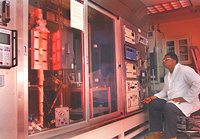 NETL is conducting fundamental and applied research in the areas of hydrogen production/separation, advanced energy systems (including integrated gasification combined-cycle), and CO2 capture and sequestration. The main goal of the hydrogen separation research is to investigate and develop materials and membranes that are suitable for the rapid, selective removal of hydrogen from coal-derived syngas at realistic conditions. NETL is leading research efforts in gas cleanup (from gasification streams); pre- and post-combustion removal of CO2 and other greenhouse gases; and removal of other gaseous contaminants. For example, onsite researchers are studying ways to clean up coal-derived synthetic gas, removing impurities to make it less corrosive to turbines and more efficient. Collectively, this research is designed to improve efficiency and reduce greenhouse gas emissions of current energy producing technologies, help develop and demonstrate energy technologies of the future, and reduce America 's dependence on foreign oil. NETL is conducting fundamental and applied research in the areas of hydrogen production/separation, advanced energy systems (including integrated gasification combined-cycle), and CO2 capture and sequestration. The main goal of the hydrogen separation research is to investigate and develop materials and membranes that are suitable for the rapid, selective removal of hydrogen from coal-derived syngas at realistic conditions. NETL is leading research efforts in gas cleanup (from gasification streams); pre- and post-combustion removal of CO2 and other greenhouse gases; and removal of other gaseous contaminants. For example, onsite researchers are studying ways to clean up coal-derived synthetic gas, removing impurities to make it less corrosive to turbines and more efficient. Collectively, this research is designed to improve efficiency and reduce greenhouse gas emissions of current energy producing technologies, help develop and demonstrate energy technologies of the future, and reduce America 's dependence on foreign oil.
Relevant resources:
Surface science
NETL is at the forefront of surface science technology research, with an emphasis on developing sorbents and catalysts that address current and emerging issues in power generation and in the production and use of fuels. Problems of interest include surface segregation in metal alloys, storage and separation of gases using novel nanoporous materials, molecular transport in porous materials, and the properties of metal catalytic clusters on well defined crystallographic surfaces. NETL researchers have been leading the development of suitable regenerable sorbents, including a desulfurization sorbent that has shown great flexibility for a wide range of applications. Integrated gasification combined-cycle (IGCC) technology is one of the most advanced power generation systems, and NETL has made significant inroads in the development of cost-effective sulfur control technologies for the IGCC program. Moreover, NETL leads in technologies that obtain near-zero pollutants from coal gasification gas streams, as well as commercial pressure swing adsorption and temperature swing adsorption systems that separate and capture CO2 from gas streams.
Relevant resources:
|